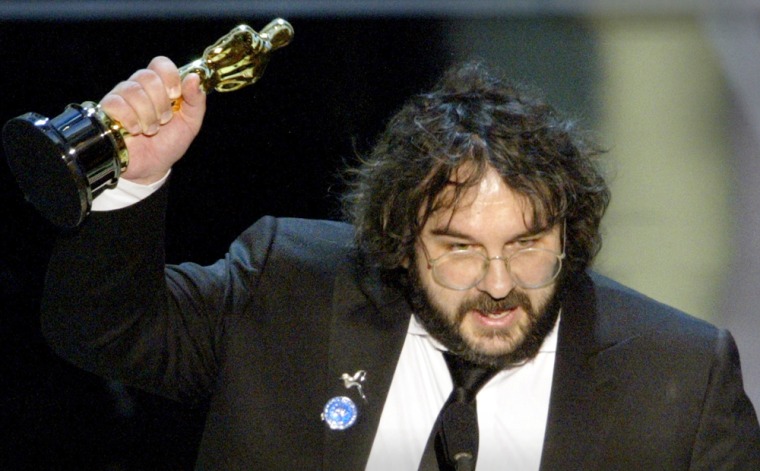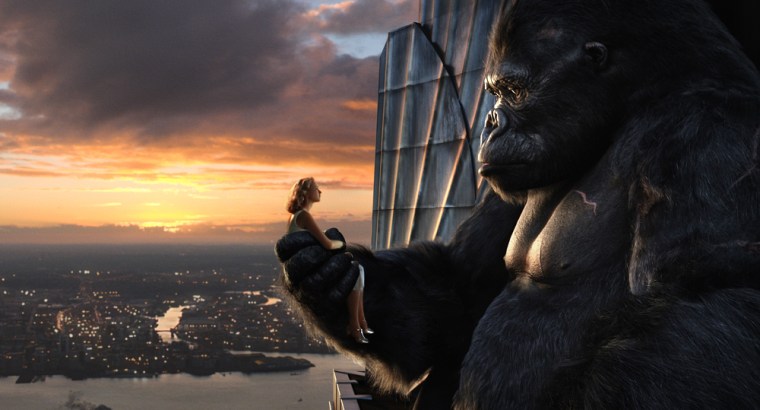Peter Jackson been called the most powerful man in Hollywood and he doesn’t even work there. The Academy Award-winning director makes his movies a world away, in his native New Zealand.
His new film, “King Kong” may be the most audacious film reprise Hollywood has ever seen. But for its 44-year-old director, this, more than any other film, was a labor of love.
Jackson was 9 years old, at home in a coastal village in New Zealand, when he first saw the original “King Kong” on television. The special effects fascinated him, but it was the story of a lost world, a beautiful woman and a doomed giant that captured his heart.
Peter Jackson, director: I’d never heard of “King Kong.” But I sat there and I watched this film and it just had such a profound effect on me. It was the defining moment in my life as a filmmaker. It was a time that I said that’s what I want to do. I want to make movies just like “King Kong.” You know, dinosaurs, big gorillas— it’s everything that a nine year-old boy would fall in love with. And then most importantly at the end of it, I cried. So it had that emotional attachment as well, which a lot of escapism doesn’t have.Stone Phillips, Dateline anchor: What made you cry?Jackson: There’s something incredibly tragic about Kong. You feel almost feel ashamed to be a human being when you see what happens to him. I mean he is ultimately a pure-heart.
We met Jackson at his production headquarters in Wellington, New Zealand. He was just weeks away from the film’s December 14th opening, the culmination of months of exhausting, but exhilarating work.
On the day of our visit, Jackson’s editing team was putting the finishing touches on the soundtrack.
Jackson: The music in a film like this is as critical as anything because Kong is mute. He doesn’t talk.
Jackson isn’t the first to remake “King Kong,” but it’s hard to imagine anyone better suited to the task. Universal pictures, owned by the same company that owns NBC (MSNBC.com is a joint-venture between Microsoft and NBC Universal News), is counting on him to make a $200 million investment pay off.
From the beginning, Jackson’s goal was to honor the original 1933 film, but use today’s technology to bring the story he loves to a whole new audience.
Jackson: There’s a generation of children who don’t like black and white movies. There’s a level of impatience or intolerance now. And I don’t know why it is, it’s maybe video games, but certainly it’s a cultural thing, it’s a generational thing—but certainly by presenting the story with the technology that we have. At least it’s a way of exposing a new generation to what is a great cinematic tale.Phillips: How did you feel you could improve it?Jackson: Well, I never use the word "improve." I tried to do the remake of Kong that I wanted to do when I was 12 years old. I got my parents’ little Super 8 camera and I tried to animate this rubber Kong that I made and I had a cardboard model of the Empire State Building and I was this sort of ambitious 12-year-old. I spent more time making the models than I did actually filming.Phillips: Is it true you requisitioned one of your mother’s coats for Kong’s fur?Jackson: She volunteered, yes. It was a fur fox stole and I snipped it off to get the fur and glued it on a strand at a time.
Jackson would set Kong aside for decades, as he learned the art of filmmaking. In 1988, he completed his first, full length feature: “Bad Taste” was a splatter film with a comic sensibility and drew attention to the talents of the obscure 26-year-old director from down under.
But it was the 1994 drama, “Heavenly Creatures” that set him on his way. It earned Jackson and co-writer Fran Walsh, the mother of his two children, their first Academy Award nomination.

For most directors, the “Lord of the Rings” would have been a career capper. The trilogy earned billions at the box office and won Jackson and Walsh three Oscars. Finally, he had the acclaim, the clout, and the resources to make the movie of his dreams and take his own journey to a mysterious island.
Jackson: I wanted people to believe that there could still be this little undiscovered piece of the world that survives still on Skull Island.Phillips: Is that an idea you want to hold onto?Jackson: Oh sure, I think it’s vital to hold onto those ideas. If you don’t have those ideas the world suddenly becomes a really boring place.
The ship that sails to Skull Island in the movie is, in reality, a rusty old trading vessel still docked in Wellington. It was purchased for the film complete with 40 tons of frozen tuna in the hold. Using hammers, nails, and plywood painted to look like metal, Jackson’s team transformed her into a 1930’s vintage steamer. But the tools used to recreate depression era New York City and Kong, himself, were far more sophisticated.
Joe Letteri, visual effects producer for “King Kong”: One of the first things we started on for the film was building New York. We didn’t know where we wanted to shoot in New York so we decided to build all of it. (laughs) Phillips: All of New York?Letteri: Yes. Phillips: How detailed did it get?Letteri: Down to the level of the doorknob, window shades. Hat stands, and lamps.
New York City, 1933, was brought to life not only by computers and miniatures, but also by a four block, street-level set built in Wellington.
As challenging as all that was, Jackson knew the true test was the title character— and understanding the computer-generated creature on an emotional level the key to success.
Jackson: People call Kong “a monster.” He’s not. There’s nothing evil about Kong. He’s just another creature who has opened up a little bit of his heart to Ann and it proves to be his undoing.
To guide them in their creation of Kong, Jackson and his team even developed a back story for the giant gorilla.
Jackson: I figured he’s about, probably about 125 years-old. He would’ve had a mother and father once but obviously not anymore. He’s the last of his species. He’s had a bad encounter with a T. Rex at one stage. It’s left a big scar, a drooping eye; he’s got a jaw that’s broken and it’s set in a crooked kind of way.
Richard Taylor, in charge of creatures, make-up, and miniatures, helped come up with Kong’s battle-worn look. He says that when Jackson couldn’t describe what he wanted in words, he acted it out.
Richard Taylor, Jackson’s production team member: Peter trying to tell us what he wants Kong to look like is hilarious— the crooked jaw. And, you know, I don’t know how many times Peter had to show that to us to get us to understand how hangdog he wanted the eyelid. It’s just a wonderful way that he can communicate with a group of creative people that think visually.
Phillips: How do you take the audience inside Kong when he can’t speak a word?Jackson: It’s all through the eyes. And we spent a lot of time with our computer effects people building all the muscles around his eyes, because his eyes became so important. And even though his eyes are just a collection of pixels in a computer, we wanted them to have depth; we wanted to see emotion in them and so all of the muscles around the eyelids and the eyebrows they’re very, very complicated bits of computer modeling and we can get a huge lot of expression. Phillips: Where did you get his roar?
Jackson: There’s various animals, lion and tigers in there, but it’s actually also Andy Serkis, it’s a human voice.
Serkis, whose performance helped animators bring Gollum to life in “The Lord of the Rings” was the stand-in for Kong, who existed only in the virtual world.
Jackson: We developed a very sophisticated electronic box which was known as the ‘Kongaliser.’ Andy’s breathing and his roaring and every noise was being fed through this mega-amplifier that would literally make the studio shake.
The result is a more realistic Kong and a more plausible bond between the gorilla and the girl. Screenwriter and co-producer, Philippa Boyens, says this is Kong, not as boyfriend, but as the ultimate bodyguard.
Philippa Boyens, co-producer and screenwriter: Kong usually takes these women, he usually kills them. It’s part of his ritual. It’s what he does. And then he doesn’t. Why doesn’t he killer her? What is it about her? One of the things that we felt was he has been alone for so long, he is the alpha male of this jungle. He is, has survived alone for a very long time, he’s very old. And then suddenly he reforms this connection. Peter described it really well. He said “It’s not a love story, but it is a story about love.”Phillips: How much do your films say about you personally? Jackson: What is the truth is that every one of my films is a film that I’d love to go see, and I think that’s very important because I always think it’s a mistake to make movies for other people, or to make them for a demographic, or try to second guess an audience. I mean I don’t do that. My favorite sequence, which in a way is the reason why I made the movie, is the Empire State Building sequence at the end. That’s a sequence that sticks in my mind as a 9 year-old seeing “King Kong.” And it was the first sequence that I worked on when we were doing this remake. Phillips: What was the key for you to that scene?Jackson: Well, the key is the emotion. The key is, it’s the tragedy; it’s this terrible inevitability that you know as Kong climbs the Empire State Building you know what’s going to happen.
In the 1933 original, the Kong that plunges to his death was a model, about 5 inches tall. Now, the gorilla model is another precious relic in Jackson’s collection.
Jackson: What I love about films is that you can see “King Kong” and you can be affected by it and then you realize that he was just this little guy when he made that fall. I mean I was in tears when I was a kid watching him fall down the side of a building and here he is, the thing that I was shedding tears over. But he’s a very special little chap; one of the things that inspired me to become a filmmaker.
This simple figure made of animal fur, wood, and string helped fire the imagination of a young Peter Jackson. He’s about to find out if his high-priced, high-tech epic wields the same power.
Boyens: He truly loves this story and it’s about the possibility that Skull Island still exists. And, for him, I think it does and Kong does, too. Phillips: What would the 9 year-old Peter Jackson think of this remake?Jackson: Oh, I think he’d like it because I think there’s still a little bit of that 9 year-old in me and I’m pretty happy.
Jackson told us it took 12 days for one computer to produce one second of the animated Kong. Fortunately, he says he had a thousand computers to speed up the process. But he left that work to others, because he told us he’s useless at the computer, and can’t even send e-mail.
